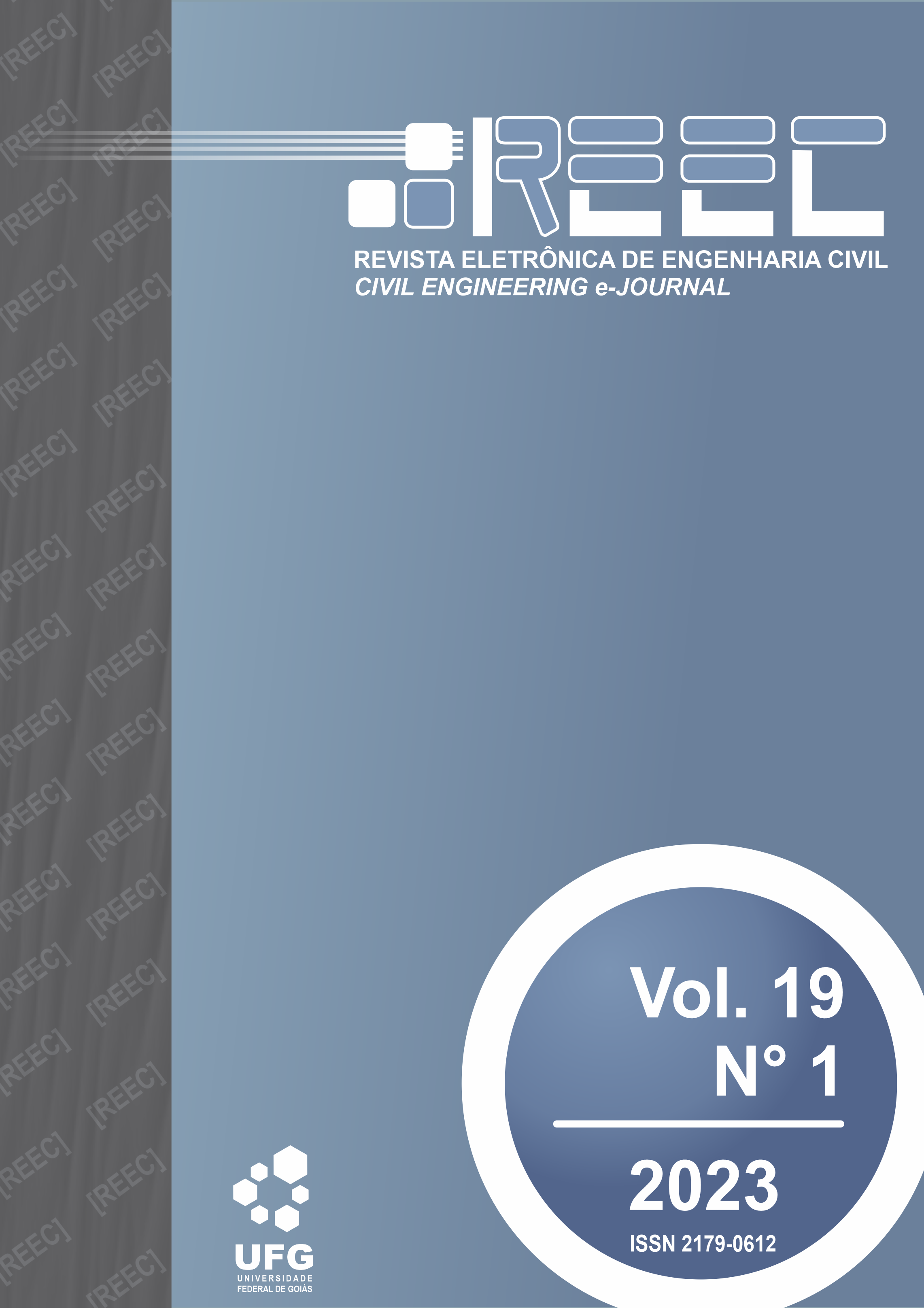Modular blocks with crushing by-products: Influence of Inorganic Pigments
DOI:
https://doi.org/10.5216/reec.v19i1.74966Keywords:
Modular blocks, Pigments, Water absorption, Compressive strength, SEMAbstract
ABSTRACT: This research aimed to evaluate the effect of the addition of inorganic pigments in red, yellow, and green colors in blocks intended for modular construction. The blocks were manufactured with the mix 1:5 (cement: total aggregates), in mass, using artificial sand, filler and micro filler as aggregates; all crushing by-products. Reference mix (0%) and 5%, 10% and 15% of the pigments were incorporated in relation to the cement mass and in partial replacement of the filler. To make the blocks, a hydraulic press with a pressing capacity of 8.0 ton was used. Block densities were determined, and total water absorption and compressive strength tests were performed. Furthermore, to analyze the effects of pigments on the porosity of the blocks, Scanning Electron Microscopy (SEM) tests were carried out, which indicated a denser microstructure for the blocks that showed lower total water absorption. It was also found that the effect of adding pigments varies according to the shape of the grains and the percentage of pigment. The blocks that had the best mechanical performance were those with 5% of yellow pigment, 10% and 15% of green pigment and 15% of red pigment, all of which performed better than the reference blocks without pigment.
Downloads
References
AGUIAR, C.A. Concreto cimento Portland branco estrutural: análise da adição de pigmentos quanto à resistência à compressão. Dissertação de mestrado, Universidade Federal do Rio Grande do Sul, Porto Alegre, RS, Brasil, 2006.
ARES, M.C.Z.; GONZÁLES, E.V.; GÓMES, A.I.T.; FERNÁNDES, J.M. An easy method to estimate the concentration of mineral pigments in colored mortars, Dyes and pigments v. 101, pp. 329-337, 2014.
ASSOCIAÇÃO BRASILEIRA DE NORMAS TÉCNICAS (ABNT). NBR 12023. Solo-cimento: ensaio de compactação. Rio de Janeiro, 1992.
______ NBR 12118. Blocos vazados de concreto simples para alvenaria: Métodos de ensaio. Rio de Janeiro, 2007.
______ NBR 6136. Blocos vazados de concreto simples para alvenaria: Requisitos. Rio de Janeiro, 2007.
BACARJI, E.; SOUTO, S. L.; MENDES, L.M.N. Blocos modulares para alvenaria com resíduos minerais: efeito da incorporação de pigmentos. In: XXXVI Jornadas Sul-Americanas de Engenharia Estrutural Montevidéu, Uruguai, 2014.
CONCEIÇÃO, L. B. Estudo da tecnologia e aplicação do concreto colorido em habitações de interesse social, Trabalho de conclusão de curso, Universidade Federal do Rio de Janeiro, Rio de Janeiro, RJ, Brasil, 2015.
CORINALDESI, V. MONOSI, S.; RUELLO, M.L. Influence of inorganic pigments’ addition on the performance of coloured SCC. Construction and Building Materials, v. 30, pp. 289-293, 2012.
D’AMICO, M.A. Metodologia de dosagem de solo-cimento para a fabricação de tijolos. Dissertação de mestrado, Escola Politécnica da Universidade de São Paulo. São Paulo, SP, Brasil, 1983.
ENOS, D.E. A problem study of soil-cement. Monografia. Michigan State College of Agriculture and Applied Science, 1948.
GUPTA, V.; PATHAK D.K.; KUMAR, R.; MIGLANI, A.; SIDDIQUE, S.; CHAUDHARY, S. Production of colored bi-layered bricks from stone processing wastes: Structural and spectroscopic characterization. Construction and Building Materials. 278, 122339, 2021.
HORGNIES, M.; CERETTI, E.D.; GUEIT, E.; AUCOUTURIER, M. Characterization of the variations of tint and adhesion of pigments onto the surface of mortar. Construction and Building Materials, v. 94, pp. 380-386, 2015.
JACKSON, J.O. The effect of leaching on soil-cement, International Journal of Rock Mechanics and Mining Sciences and Geomechanics, v. 11, pp. 215-219, 1974.
LEE, H.S.; LEE, J.Y.; YU, M.Y. Influence of inorganic pigments on the fluidity of cement mortars, Cement and concrete Research, v. 35, pp. 703-710, 2005.
LEE, H.S.; LEE, J.Y.; YU, M.Y. Influence of iron oxide pigments on the properties of concrete inter-locking blocks, Cement and concrete Research, v. 33, pp. 1889-1896, 2003.
LI, H.; YANG, X.; XU, W.; WU, J.; XU, J.; ZHANG, G.; XIA, Y. Application of dry composite electro-plating sludge into preparation of cement-based decorative mortar as green pigment. Journal of cleaner Production, v. 66, pp 101-106, 2014.
LIMA, F.X.R.F. Estudo de aplicação de resíduo de argamassa de cimento em tijolos de solo-cimento e sua influência no desempenho térmico das edificações. Dissertação de mestrado, Programa de Pós-Graduação em engenharia do Meio Ambiente, Universidade Federal de Goiás. Goiânia, GO, Brasil, 2007.
LIMA, T.V.; ALEXANDRE, J. Estabilização de três solos argilosos para a produção de blocos ecológicos (solo-cimento). In: XI Encontro Nacional de Tecnologia no Ambiente Construído. Florianópolis, SC, Brasil, 2006.
MARIN, J. D. B.; ARCE, A. E.; ARCE, J. E. Use of an industrial solid waste as a pigment in clay bricks and its effects on the mechanical properties. Construction and Building Materials. 306, 124848, 2021.
MIRANDA, R.A.C. Estudo da aplicação de resíduo de marmorarias em Tijolos de solo cimento. Dissertação de mestrado, Programa de Pós-Graduação em engenharia do Meio Ambiente, Universidade Federal de Goiás. Goiânia, GO, Brasil, 2007.
MORAES, M.B. Estudo das trincas em paredes de alvenaria auto-portante de tijolos e blocos de solo-cimento. Dissertação de mestrado, Escola Politécnica da Universidade de São Paulo. São Paulo, SP, Brasil, 1982.
Observatório das Metrópoles. Análise das regiões metropolitanas do Brasil. Prof. Dr. Aristides Moysés (Coordenação Regional). Observatório das Metrópoles: núcleo Goiânia GEPUR-CO/UCG/SEPLAM. dez, 2005.
PAVLOVA, I. A.; SAPOZHNIKOVA, M. A.; FARAFONTOVA, E. P. Lightening of ceramic bricks based on red-burning clay. IOP Conference Series: Materials Science and Engineering. 687, 022021, 2019.
PIOVESAN, A.Z. Estudo sobre a influência da adição de pigmentos em propriedades de durabilidade e na cromacidade do concreto de cimento Portland branco. Dissertação de mestrado, Programa de Pós-graduação em Engenharia Civil, Universidade Federal do Rio Grande do Sul, Porto Alegre, RS, 2009.
PRUSI, G.A. An experimental investigation of soil-cement as a building material. Monografia. Michigan State College of Agriculture and Applied Science, 1942.
SANTOS, M.D. Construção com terra crua: viabilidade tecnológica e energética em habitações sociais. Dissertação de mestrado, Programa de Pós-Graduação em Tecnologia, Centro Federal de Educação Tecnológica do Paraná, Curitiba, PR, Brasil, 2002.
STOLBOUSHKIN, A.; AKST, D.; FOMINA, O.; IVANOV, A. Structure and properties of ceramic brick colored by manganese-containing wastes. MATEC Web of Conferences 143, 02009, 2018.
WANG, M. C.; MOULTROP, K.; NACCI, V.A. Study of soil cement with chemical additives. International Journal of Rock Mechanics and Mining Sciences and Geomechanics, v. 14(2), pp. 31-31, 1977.
Downloads
Published
How to Cite
Issue
Section
License
Autores que publicam nesta revista concordam com os seguintes termos: Autores mantém os direitos autorais e concedem à revista o direito de primeira publicação, com o trabalho simultaneamente licenciado sob a Licença Creative Commons Attribution que permite o compartilhamento do trabalho com reconhecimento da autoria e publicação inicial nesta revista.
![[REEC] Revista Eletrônica de Engenharia Civil](https://revistas.ufg.br/public/journals/30/pageHeaderLogoImage_pt_BR.png)



